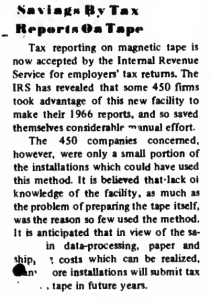Sept. 13, 1967: Americans file tax returns on magnetic tape
Before TurboTax and electronic filing, Americans once submitted their tax returns on magnetic tape.
Tax preparation software like TurboTax has infused automation into the otherwise burdensome process of filing a tax return. Users of such software are guided through a series of simple questions while algorithms handle calculations and filling out the appropriate forms to send to the IRS. When the form is ready, users just hit “send” and the process is complete.

Long before these automated systems were invented, tax returns were a paper-only endeavor. The slow evolution from paper to a digitized system began in 1966 when the IRS began accepting employer tax returns on a data storage medium called magnetic tape. First used for computer data entry in 1951, magnetic tape replaced punch cards and became a primary means of data storage in the 1960s. The tapes consisted of a narrow strip of plastic film coated in magnetizable metals such as ferric oxide.
In 1966, 450 companies collectively filed several million tax records across a few hundred reels of magnetic tape, according to Computerworld magazine and the 1966 IRS Annual Report. Replacing paper filings with magnetic tape generated substantial savings for both taxpayers and the IRS. For companies, filing returns on magnetic tape saved on costs associated with processing forms, paper, and shipping. For the IRS, magnetic tapes eliminated the need to transcribe data from millions of paper documents into punch cards and subsequently magnetic tapes. These benefits led to accurate predictions that more companies would take advantage of digitized filing in subsequent years.
While the vast majority of Americans now file their tax returns electronically, the digital transformation of the tax filing system remains incomplete. Around 15 million taxpayers filed their returns on paper in 2019, contributing to a months-long backlog of millions of pieces of unopened mail at the IRS. Once the mail is eventually opened, the IRS will store the tax return data in one of their data storage media, which include modern magnetic tapes. Magnetic tape technology has improved dramatically since 1966, with storage capabilities increasing from megabytes to terabytes per reel. Many institutions besides the IRS, including Google and Microsoft, also still rely on magnetic tapes for archiving data.
–By Kathleen Esfahany